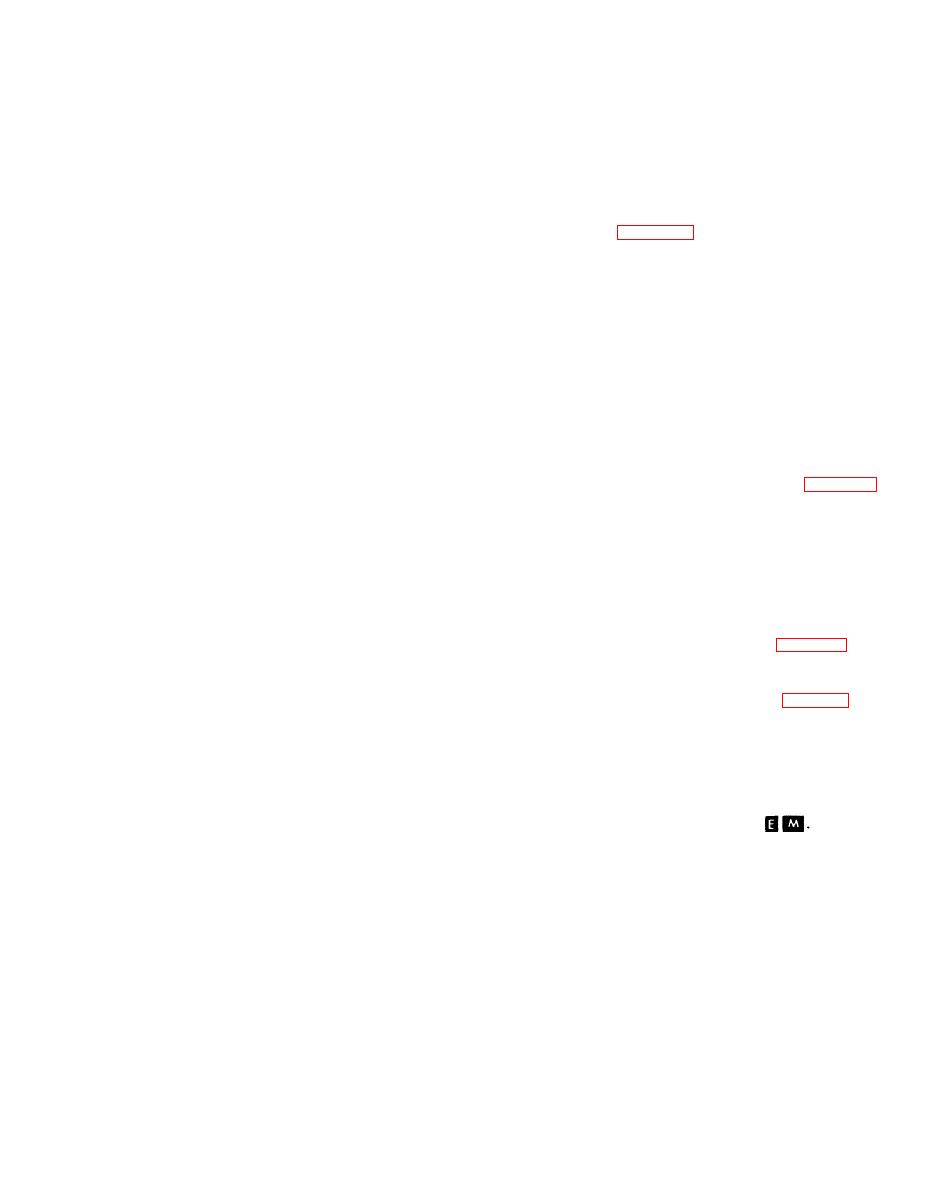 |
|||
|
|
|||
|
|
|||
| ||||||||||
|
|
 TM 9-1270-212-14&P
loosened so the serrated cuts in the rail support can be
borescope is removed. An operator sighting through the
moved in relation to the serrations in the square washers.
TSU and setting the ACQ TRK STOW switch to ACQ
The choice of which support to adjust should be made so as
should see the TSU crosshairs centered on the TSU optics
to keep the slots in the rail supports centered. The
target. If the TSU crosshairs are not aligned, the electrical
serrations provide adjustments in 1-mil increments. The
output signals of the HSS must be altered slightly to
mechanical azimuth should be made as accurate as possible
provide coincidence.
to minimize crosscoupling in subsequent electrical azimuth
adjustments. Use care when tightening the nuts to insure
the elevation discrepancies recorded at the two 90-degree
that the serrations are matched. Check the alignment with
positions. Note that a straight line between the 90-degree
the borescope before removing the LOD. The pilot rails are
adjusted in like manner, using the borescope to sight on the
positions does not pass through the center point. This
pilot HSS target, except that the LOD rail clamp base is
example represents a composite of roll error (the ends are
secured in the 5.5-degree position for alignment of the pilot
not parallel to the reference lines established by the targets)
linkage in XM136.
and the pitch error (the three points are not in the same
plane). The goal of the adjustments is to make corrections
f. The next boresighting step is to align the rails to the
until the sighting points plot as shown in step D of figure
roll axis of the helicopter. The bubble level on the LOD is
4-7. The roll adjustment is made first by rotating the roll
used to accomplish this alignment. The bubble level has a
adjustment screws at each end of the linkage rails in
5-minute bubble; that is, each mark on the bubble
l/4-turn (90-degree) increments. It is important to turn the
represents 5 minutes of a degree; 5/60ths equal 1/12th
screws at each end in equal amounts to maintain the rail
degree, which equals 1.48 mils. The LOD is used to transfer
ends parallel to each other while flattening the roll plane to
the roll position of the TSU boresight device to the linkage
bring the sightings level, as shown in step B of figure 4-7.
rails. The LOD is placed on the TSU boresight device, with
Note that the three sightings are not yet in the same plane.
the bubble facing forward, and the thumbscrews are
Adjustment of resolver B1 in the linkage affects only the
adjusted to carefully center the bubble. The LOD is
center sighting and is called the pitch adjustment.
carefully attached to the forward and then the aft end of
Therefore, the next adjustment is to raise the center
the gunner and pilot rails, and the rails are adjusted at each
sighting point by adjusting the worm sector attached to the
end to center the bubble. (The LOD rail clamp base is
body of resolver B1. The worm sector provides a l-in-l7 gear
secured to the 5.5degree position for the pilot linkage in
reduction and a resolver body travel of 20 degrees
HSS XM136 and in the 0-degree position for the other
minimum. When the pitch error has been corrected, the
linkages.) The mechanical adjustments are now complete.
typical pattern should look like step C in figure 4-7. The
next step is to correct the elevation of all three by adjusting
NOTE
the EL potentiometer on the EIA until the three sightings
are in the same plane, as shown in step D in figure 4-7. The
Before power is applied, each of the four
final step is to correct azimuth (if necessary) by adjusting
boresight potentiometers on the EIA must be
the AZ potentiometer on the EIA. The methods for the
set to the approximate midpoint of its limits.
pilot linkage are the same except that the LOD rail clamp
g. T h e remaining boresighting adjustments are
base is secured in the 5.5-degree position for the pilot's rails
in HSS XM136.
accomplished with the HSS operating. The LOD is carefully
attached to the forward end of the gunner rails with the
1-24. HSS Boresighting Theory. AH-1S
level forward, and the gunner linkage is attached to the
magnet on the LOD. The LOD elevation and azimuth locks
Refer to TM 9-1090-206-30, Aviation Intermediate
are slightly loosened and the borescope is inserted in the
Maintenance Manual for Armament Subsystem, Helicopter:
LOD adapter. The LOD is moved as required to center the
20-mm Automatic Gun, XM97E1, for composite bore-
borescope crosshairs on the gunner HSS target of the center
sighting procedures.
target. When the borescope is centered on the target, the
LOD elevation and azimuth locks are tightened, and the
1-25
|
|
Privacy Statement - Press Release - Copyright Information. - Contact Us |